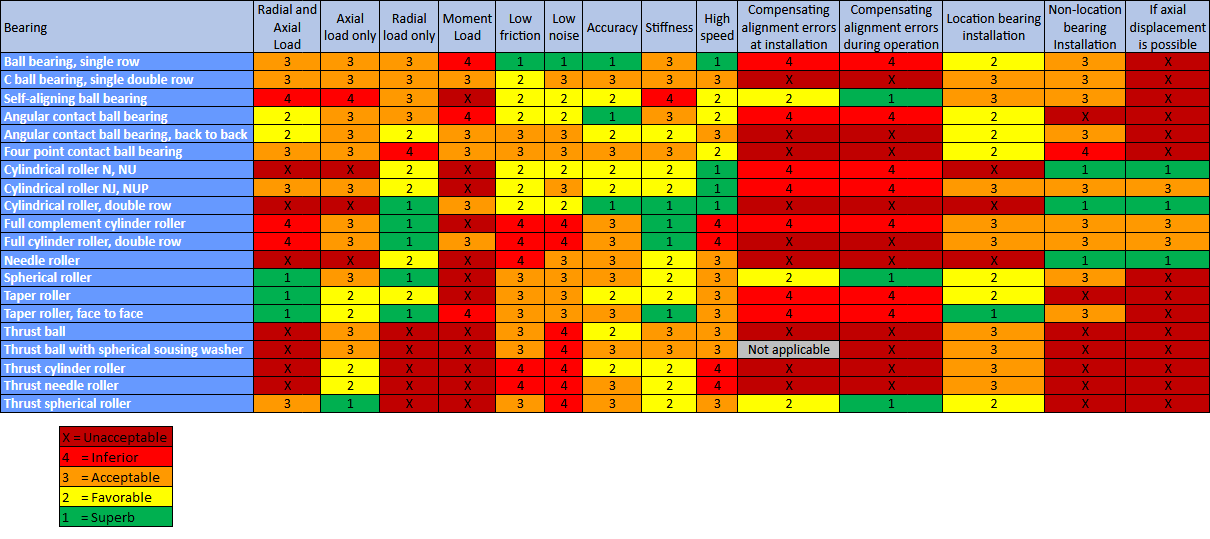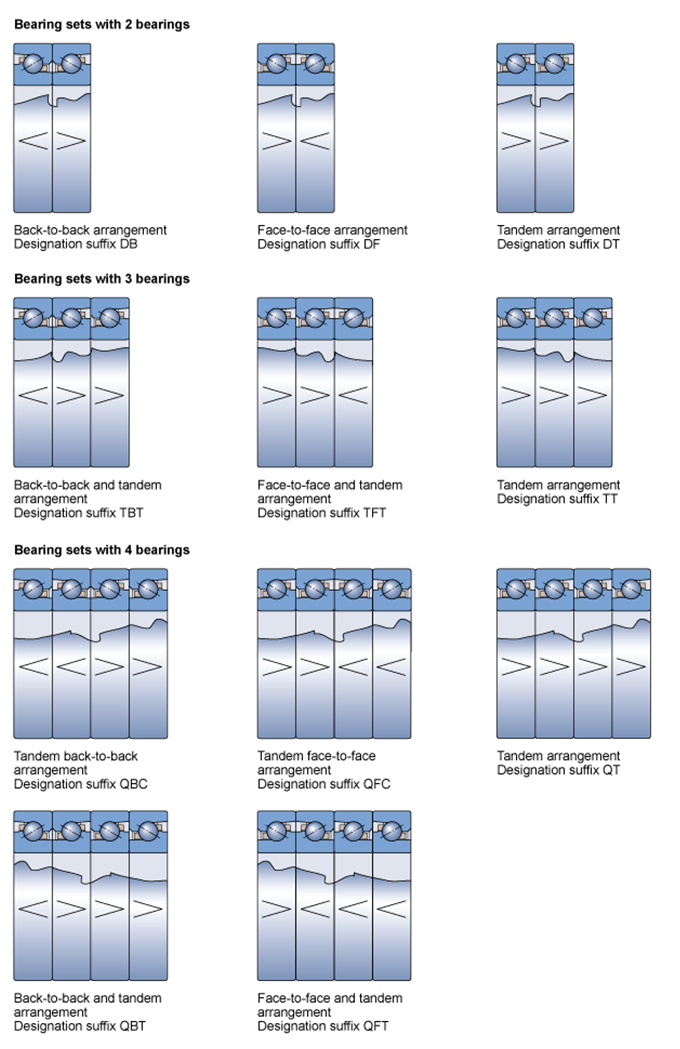Bearing Selection: Difference between revisions
(Created page with "The selection of bearings is consists of the following steps which are described in further detail on this page; 1. Select bearing type suitable for load condition 2. Select...") |
No edit summary |
||
| Line 16: | Line 16: | ||
== Selection of bearing arrangement == | == Selection of bearing arrangement == | ||
There are three basic bearing arrangements: | |||
1. Face to face | |||
2. Back to back | |||
3. Tandem | |||
These arrangements can also be combined. | |||
[[File:Bearing arrangements.png]] | |||
'''Back-to-back arrangement''' | |||
In a back-to-back arrangement, the load lines diverge along the bearing axis. | |||
Axial loads acting in both directions can be accommodated, but only by one bearing or bearing set in each direction. | |||
Bearings mounted back-to-back provide a relatively rigid bearing arrangement. | |||
The wide span between bearing effective centres makes this arrangement particularly well suited to support moment loads." | |||
'''Face-to-face arrangement''' | |||
In a face-to-face arrangement, the load lines converge along the bearing axis. | |||
Axial loads acting in both directions can be accommodated, but only by one bearing or bearing set in each direction. | |||
The shorter span between effective bearing centres makes face-to-face arrangements less suitable to | |||
support moment loads compared to bearings in a back-to-back arrangement." | |||
'''Tandem arrangement''' | |||
The use of a tandem arrangement provides increased axial and radial load carrying capacity compared to a single bearing. | |||
In a tandem arrangement, the load lines are parallel so that radial and axial loads are shared. | |||
The bearing set can only accommodate axial loads acting in one direction. | |||
If axial loads act in both directions, or if combined loads are present, additional bearing(s) adjusted against the tandem arrangement must be added." | |||
'''Examples''' | |||
Universally matchable single direction bearings can be arranged in various ways depending on the stiffness and load requirements of the application. | |||
The possible arrangements are shown in the image, including the applicable designation suffixes for matched sets. | |||
If misalignment cannot be avoided between the bearing positions, face-to-face bearing arrangements are recommended. They are less sensitive to | |||
misalignment than back-to-back bearing arrangements. | |||
Combinations of tandem arrangements with back-to-back or face-to-face arrangements are usually selected to maximize the stiffness or load carrying | |||
capacity of a bearing set in a particular direction. This is the case, for example, when extended, preloaded, vertical or overhung screw drives must be supported." | |||
== Dimensioning of bearings == | |||
== Bearing housing design == | |||
Revision as of 13:14, 30 December 2019
The selection of bearings is consists of the following steps which are described in further detail on this page;
1. Select bearing type suitable for load condition
2. Select bearing arrangement suitable for load condition
3. Dimension bearings
4. Select bearing housing design
Selection of bearing type
The table below shows level of suitability of different bearing types for different conditions.
Selection of bearing arrangement
There are three basic bearing arrangements:
1. Face to face
2. Back to back
3. Tandem
These arrangements can also be combined.
Back-to-back arrangement
In a back-to-back arrangement, the load lines diverge along the bearing axis. Axial loads acting in both directions can be accommodated, but only by one bearing or bearing set in each direction. Bearings mounted back-to-back provide a relatively rigid bearing arrangement. The wide span between bearing effective centres makes this arrangement particularly well suited to support moment loads."
Face-to-face arrangement
In a face-to-face arrangement, the load lines converge along the bearing axis. Axial loads acting in both directions can be accommodated, but only by one bearing or bearing set in each direction. The shorter span between effective bearing centres makes face-to-face arrangements less suitable to support moment loads compared to bearings in a back-to-back arrangement."
Tandem arrangement
The use of a tandem arrangement provides increased axial and radial load carrying capacity compared to a single bearing. In a tandem arrangement, the load lines are parallel so that radial and axial loads are shared. The bearing set can only accommodate axial loads acting in one direction. If axial loads act in both directions, or if combined loads are present, additional bearing(s) adjusted against the tandem arrangement must be added."
Examples
Universally matchable single direction bearings can be arranged in various ways depending on the stiffness and load requirements of the application. The possible arrangements are shown in the image, including the applicable designation suffixes for matched sets. If misalignment cannot be avoided between the bearing positions, face-to-face bearing arrangements are recommended. They are less sensitive to misalignment than back-to-back bearing arrangements. Combinations of tandem arrangements with back-to-back or face-to-face arrangements are usually selected to maximize the stiffness or load carrying capacity of a bearing set in a particular direction. This is the case, for example, when extended, preloaded, vertical or overhung screw drives must be supported."

